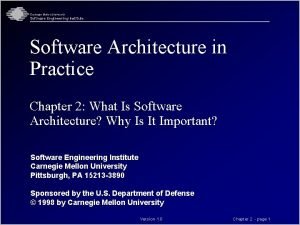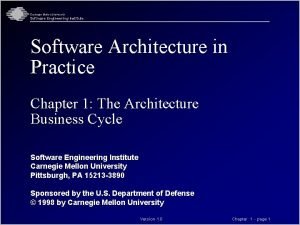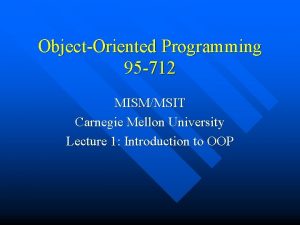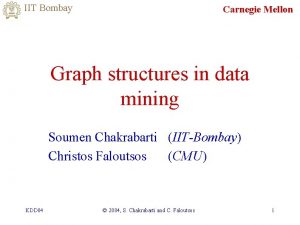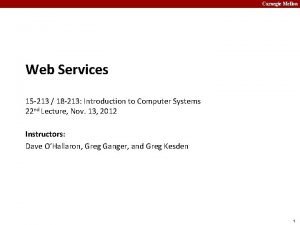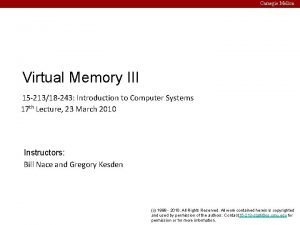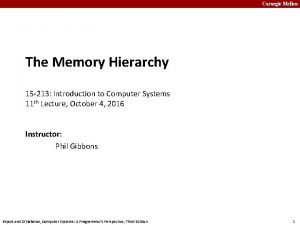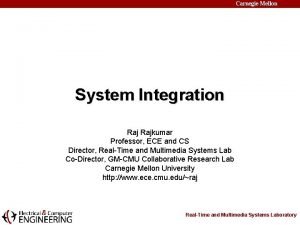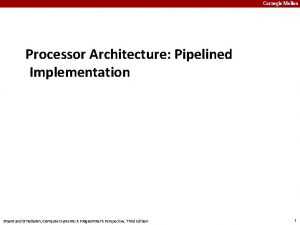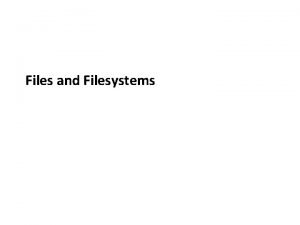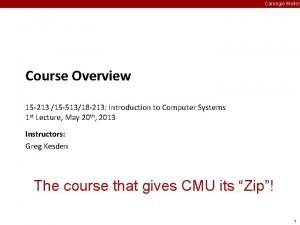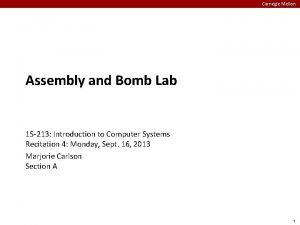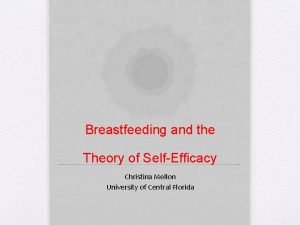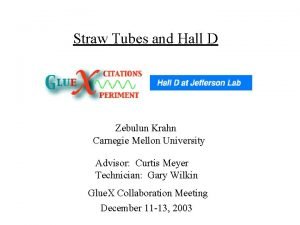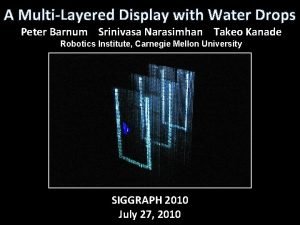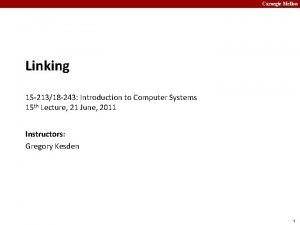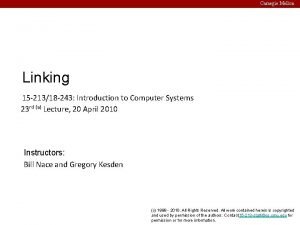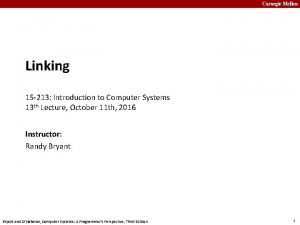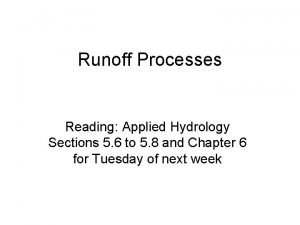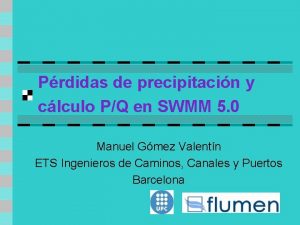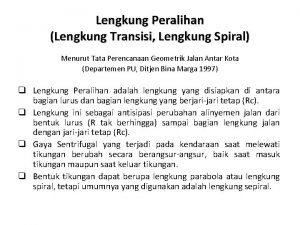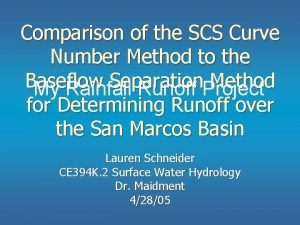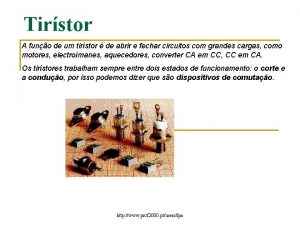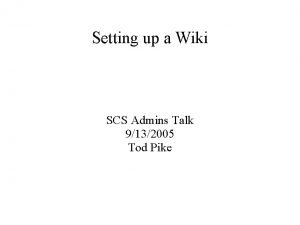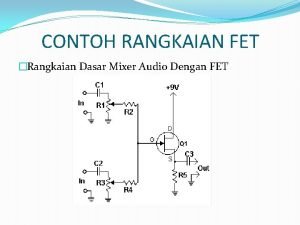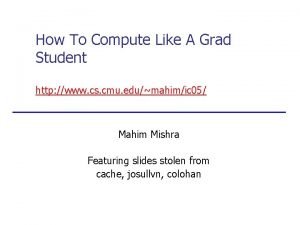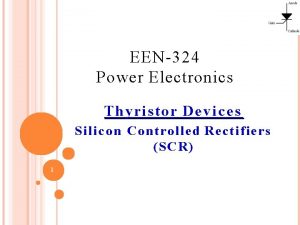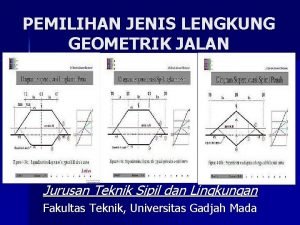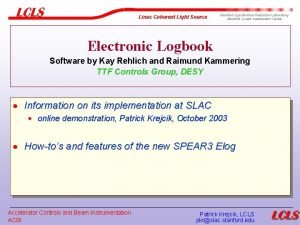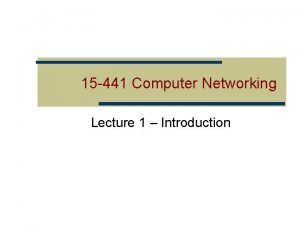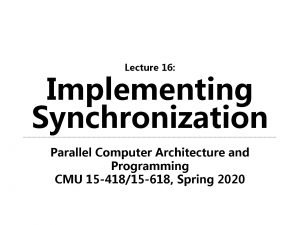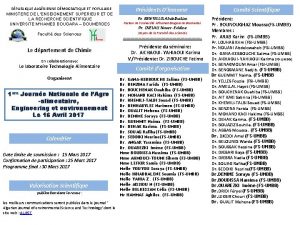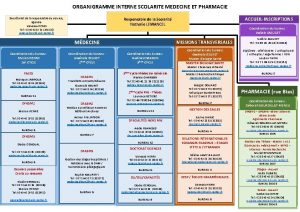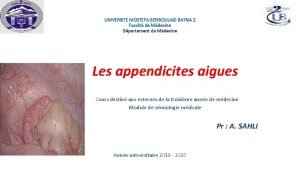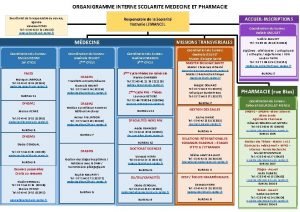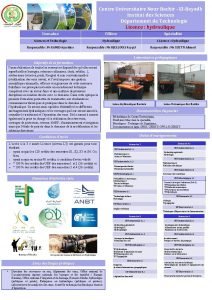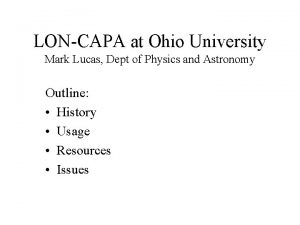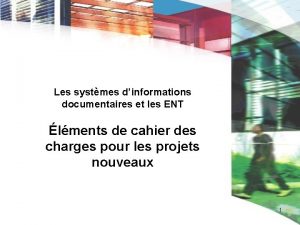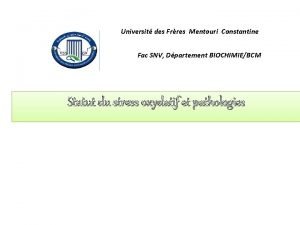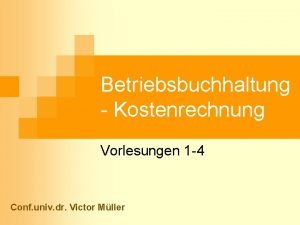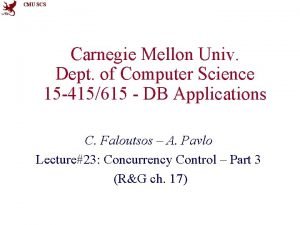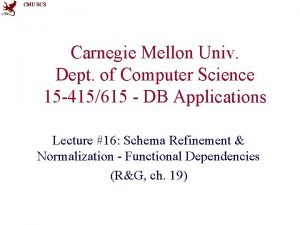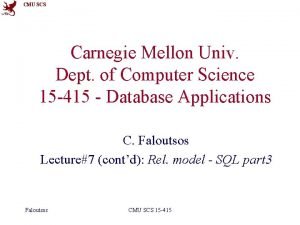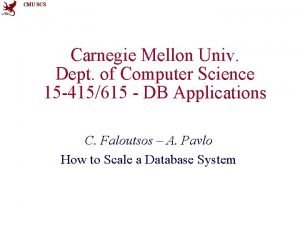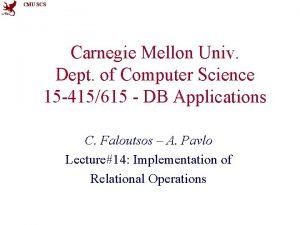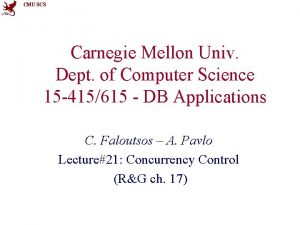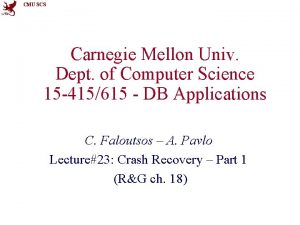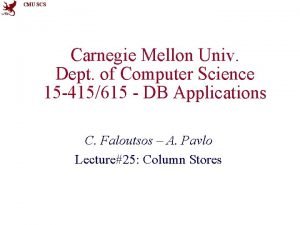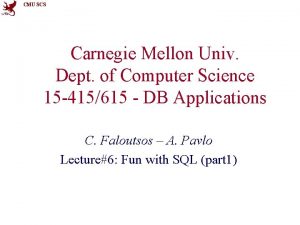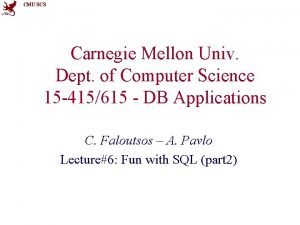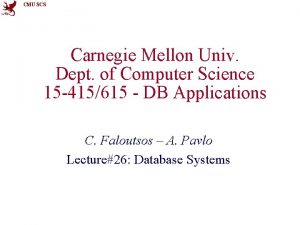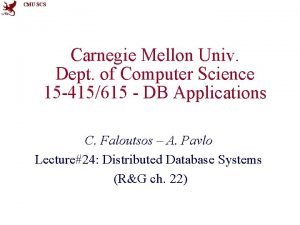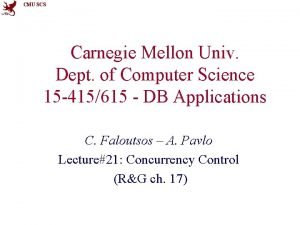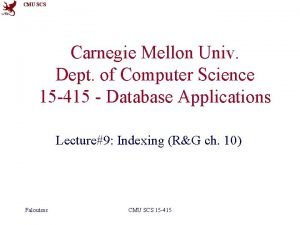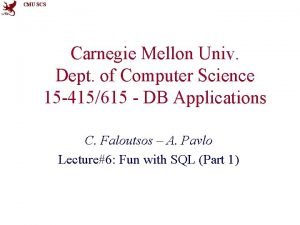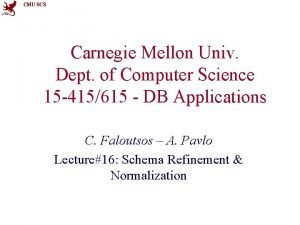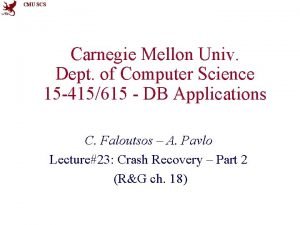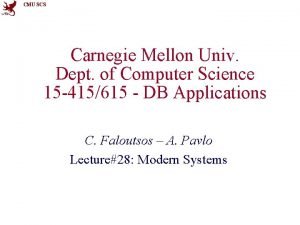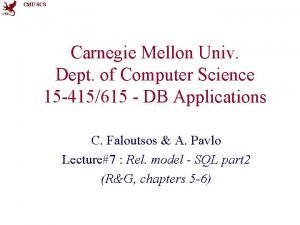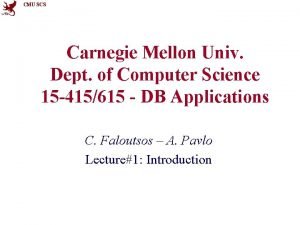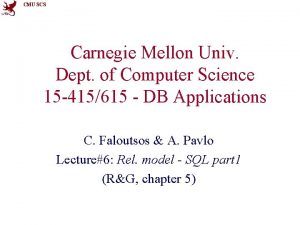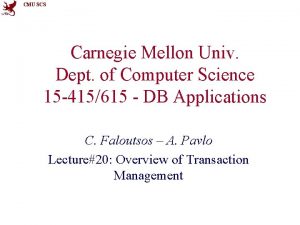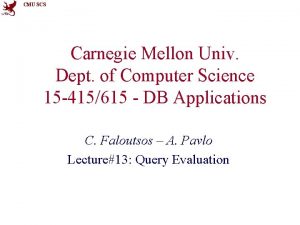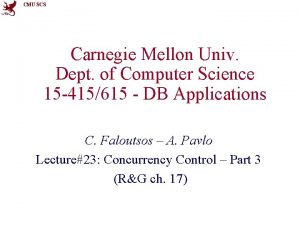CMU SCS Carnegie Mellon Univ Dept of Computer












































































- Slides: 76

CMU SCS Carnegie Mellon Univ. Dept. of Computer Science 15 -415/615 - DB Applications C. Faloutsos – A. Pavlo Lecture#23: Concurrency Control – Part 2 (R&G ch. 17)

CMU SCS Last Class • • • Serializability Two-Phase Locking Deadlocks Lock Granularities Locking in B+Trees Faloutsos/Pavlo CMU SCS 15 -415/615 2

CMU SCS Concurrency Control Approaches • Two-Phase Locking (2 PL) – Determine serializability order of conflicting operations at runtime while txns execute. • Timestamp Ordering (T/O) – Determine serializability order of txns before they execute. Faloutsos/Pavlo CMU SCS 15 -415/615 3

CMU SCS Today's Class • • Basic Timestamp Ordering Optimistic Concurrency Control Multi-Version Concurrency Control Partition-based T/O • The Phantom Problem • Weaker Isolation Levels Faloutsos/Pavlo CMU SCS 15 -415/615 4

CMU SCS Timestamp Allocation • Each txn Ti is assigned a unique fixed timestamp that is monotonically increasing. – Let TS(Ti) be the timestamp allocated to txn Ti – Different schemes assign timestamps at different times during the txn. • Multiple implementation strategies: – System Clock. – Logical Counter. – Hybrid. Faloutsos/Pavlo CMU SCS 15 -415/615 5

CMU SCS T/O Concurrency Control • Use these timestamps to determine the serializability order. • If TS(Ti) < TS(Tj), then the DBMS must ensure that the execution schedule is equivalent to a serial schedule where Ti appears before Tj. Faloutsos/Pavlo CMU SCS 15 -415/615 6

CMU SCS Basic T/O • Txns read and write objects without locks. • Every object X is tagged with timestamp of the last txn that successfully did read/write: – W-TS(X) – Write timestamp on X – R-TS(X) – Read timestamp on X • Check timestamps for every operation: – If txn tries to access an object “from the future”, it aborts and restarts. Faloutsos/Pavlo CMU SCS 15 -415/615 7

CMU SCS Basic T/O – Reads • If TS(Ti) < W-TS(X), this violates timestamp order of Ti w. r. t. writer of X. – Abort Ti and restart it (with same TS? why? ) • Else: – Allow Ti to read X. – Update R-TS(X) to max(R-TS(X), TS(Ti)) – Have to make a local copy of X to ensure repeatable reads for Ti. Faloutsos/Pavlo CMU SCS 15 -415/615 8

CMU SCS Basic T/O – Writes • If TS(Ti) < R-TS(X) or TS(Ti) < W-TS(X) – Abort and restart Ti. • Else: – Allow Ti to write X and update W-TS(X) – Also have to make a local copy of X to ensure repeatable reads for Ti. Faloutsos/Pavlo CMU SCS 15 -415/615 9

CMU SCS Basic T/O – Example #1 Schedule TS(T 2)=2 TS(T 1)=1 T 2 TIME BEGIN R(B) W(B) Database Object R-TS W-TS A 120 20 B 210 20 - - - R(A) COMMIT Faloutsos/Pavlo R(A) W(A) COMMIT No violations so both txns are safe to commit. CMU SCS 15 -415/615 10

CMU SCS Basic T/O – Example #2 Schedule T 1 T 2 Database TIME BEGIN R(A) BEGIN W(A) COMMIT Object R-TS W-TS A 10 20 - - - W(A) COMMIT Violation: TS(T 1) < W-TS(A) T 1 cannot overwrite update by T 2, so it has to abort+restart. Faloutsos/Pavlo CMU SCS 15 -415/615 11

CMU SCS Basic T/O – Thomas Write Rule • If TS(Ti) < R-TS(X): – Abort and restart Ti. • If TS(Ti) < W-TS(X): – Thomas Write Rule: Ignore the write and allow the txn to continue. – This violates timestamp order of Ti • Else: – Allow Ti to write X and update W-TS(X) Faloutsos/Pavlo CMU SCS 15 -415/615 12

CMU SCS Basic T/O – Thomas Write Rule Schedule T 1 T 2 Database TIME BEGIN R(A) BEGIN W(A) COMMIT Object R-TS W-TS A 1 - 2 - - - W(A) COMMIT We do not - update W-TS(A) Ignore the write and allow T 1 to commit. Faloutsos/Pavlo CMU SCS 15 -415/615 13

CMU SCS Basic T/O • Ensures conflict serializability if you don’t use the Thomas Write Rule. • No deadlocks because no txn ever waits. • Possibility of starvation for long txns if short txns keep causing conflicts. • Permits schedules that are not recoverable. Faloutsos/Pavlo CMU SCS 15 -415/615 14

CMU SCS Recoverable Schedules • Transactions commit only after all transactions whose changes they read, commit. Faloutsos/Pavlo CMU SCS 15 -415/615 15

CMU SCS Recoverability Schedule T 1 T 2 TIME BEGIN W(A) ⋮ ABORT BEGIN R(A) W(B) COMMIT T 2 is allowed to read the writes of T 1. This is not recoverable because we can’t restart T 2. T 1 aborts after T 2 has committed. Faloutsos/Pavlo CMU SCS 15 -415/615 16

CMU SCS Today's Class • • Basic Timestamp Ordering Optimistic Concurrency Control Multi-Version Concurrency Control Partition-based T/O • The Phantom Problem • Weaker Isolation Levels Faloutsos/Pavlo CMU SCS 15 -415/615 18

CMU SCS Optimistic Concurrency Control • Assumption: Conflicts are rare • Forcing txns to wait to acquire locks adds a lot of overhead. • Optimize for the no-conflict case. Faloutsos/Pavlo CMU SCS 15 -415/615 19

CMU SCS OCC Phases • Read: Track the read/write sets of txns and store their writes in a private workspace. • Validation: When a txn commits, check whether it conflicts with other txns. • Write: If validation succeeds, apply private changes to database. Otherwise abort and restart the txn. Faloutsos/Pavlo CMU SCS 15 -415/615 20

CMU SCS OCC – Example Schedule T 1 T 2 TIME BEGIN READ R(A) BEGIN Object Value W-TS A 456 123 20 READ TS(T 2)=1 R(A) VALIDATE WRITE T 1 Workspace COMMIT TS(T 1)=2 W(A) VALIDATE WRITE COMMIT Faloutsos/Pavlo Database - T 2 Workspace Object Value W-TS -A -123 456 -0 ∞ -A -123 -0 - - - CMU SCS 15 -415/615 21

CMU SCS OCC – Validation Phase • Need to guarantee only serializable schedules are permitted. • At validation, Ti checks other txns for RW and WW conflicts and makes sure that all conflicts go one way (from older txns to younger txns). Faloutsos/Pavlo CMU SCS 15 -415/615 22

CMU SCS OCC – Serial Validation • Maintain global view of all active txns. • Record read set and write set while txns are running and write into private workspace. • Execute Validation and Write phase inside a protected critical section. Faloutsos/Pavlo CMU SCS 15 -415/615 23

CMU SCS OCC – Validation Phase • Each txn’s timestamp is assigned at the beginning of the validation phase. • Check the timestamp ordering of the committing txn with all other running txns. • If TS(Ti) < TS(Tj), then one of the following three conditions must hold… Faloutsos/Pavlo CMU SCS 15 -415/615 24

CMU SCS OCC – Validation #1 • Ti completes all three phases before Tj begins. Faloutsos/Pavlo CMU SCS 15 -415/615 25

CMU SCS OCC – Validation #1 TIME T 1 Faloutsos/Pavlo BEGIN READ VALIDATE WRITE COMMIT T 2 BEGIN READ VALIDATE WRITE COMMIT CMU SCS 15 -415/615 26

CMU SCS OCC – Validation #2 • Ti completes before Tj starts its Write phase, and Ti does not write to any object read by Tj. – Write. Set(Ti) ∩ Read. Set(Tj) = Ø Faloutsos/Pavlo CMU SCS 15 -415/615 27

CMU SCS OCC – Validation #2 TIME Schedule T 1 T 2 BEGIN READ R(A) W(A) Database BEGIN READ R(A) VALIDATE WRITE COMMIT Object Value W-TS A 123 0 - - - T 1 Workspace T 2 Workspace Object Value W-TS -A -123 456 -0 ∞ -A -123 -0 - - - T 1 has to abort even though T 2 will never write to the database. Faloutsos/Pavlo CMU SCS 15 -415/615 28

CMU SCS OCC – Validation #2 TIME Schedule T 1 T 2 BEGIN READ R(A) W(A) VALIDATE WRITE COMMIT Database BEGIN READ R(A) VALIDATE WRITE COMMIT Object Value W-TS A 123 0 - - - T 1 Workspace T 2 Workspace Object Value W-TS -A -123 456 -0 ∞ -A -123 -0 - - - Safe to commit T 1 because we know that T 2 will not write. Faloutsos/Pavlo CMU SCS 15 -415/615 29

CMU SCS OCC – Validation #3 • Ti completes its Read phase before Tj completes its Read phase • And Ti does not write to any object that is either read or written by Tj: – Write. Set(Ti) ∩ Read. Set(Tj) = Ø – Write. Set(Ti) ∩ Write. Set(Tj) = Ø Faloutsos/Pavlo CMU SCS 15 -415/615 30

CMU SCS OCC – Validation #3 TIME Schedule T 1 T 2 BEGIN READ R(A) W(A) Database BEGIN READ TS(T 1)=1 R(B) VALIDATE WRITE COMMIT Value W-TS A 456 123 10 B XYZ 0 T 1 Workspace T 2 Workspace R(A) VALIDATE WRITE Safe. COMMIT to commit Object Value W-TS -A -123 456 -0 ∞ -B -XYZ -0 - -A -456 -1 T 1 because T 2 sees the DB after T 1 has executed. Faloutsos/Pavlo Object CMU SCS 15 -415/615 31

CMU SCS OCC – Observations • Q: When does OCC work well? • A: When # of conflicts is low: – All txns are read-only (ideal). – Txns access disjoint subsets of data. • If the database is large and the workload is not skewed, then there is a low probability of conflict, so again locking is wasteful. Faloutsos/Pavlo CMU SCS 15 -415/615 32

CMU SCS OCC – Performance Issues • High overhead for copying data locally. • Validation/Write phase bottlenecks. • Aborts are more wasteful because they only occur after a txn has already executed. • Suffers from timestamp allocation bottleneck. Faloutsos/Pavlo CMU SCS 15 -415/615 33

CMU SCS Today's Class • • Basic Timestamp Ordering Optimistic Concurrency Control Multi-Version Concurrency Control Partition-based T/O • The Phantom Problem • Weaker Isolation Levels Faloutsos/Pavlo CMU SCS 15 -415/615 34

CMU SCS Multi-Version Concurrency Control • Writes create new versions of objects instead of in-place updates: – Each successful write results in the creation of a new version of the data item written. • Use write timestamps to label versions. – Let Xk denote the version of X where for a given txn Ti: W-TS(Xk) ≤ TS(Ti) Faloutsos/Pavlo CMU SCS 15 -415/615 35

CMU SCS MVCC – Reads • Any read operation sees the latest version of an object from right before that txn started. • Every read request can be satisfied without blocking the txn. • If TS(Ti) > R-TS(Xk): – Set R-TS(Xk) = TS(Ti) Faloutsos/Pavlo CMU SCS 15 -415/615 36

CMU SCS MVCC – Writes • If TS(Ti) < R-TS(Xk): – Abort and restart Ti. • If TS(Ti) = W-TS(Xk): – Overwrite the contents of Xk. • Else: – Create a new version of Xk+1 and set its write timestamp to TS(Ti). Faloutsos/Pavlo CMU SCS 15 -415/615 37

CMU SCS MVCC – Example #1 Schedule TS(T 2)=2 TS(T 1)=1 T 2 TIME BEGIN R(A) W(A) R(A) COMMIT BEGIN R(A) W(A) Database Object Value R-TS W-TS A 0 123 10 0 A -1 -456 12 - 1 - -2 A -789 2 - 2 - COMMIT T 1 reads version A 1 that it wrote earlier. Faloutsos/Pavlo CMU SCS 15 -415/615 38

CMU SCS MVCC – Example #2 Schedule T 1 T 2 TIME BEGIN R(A) COMMIT W(A) Database Object Value R-TS W-TS A 0 123 210 0 - - - Violation: TS(T 1) < R-TS(A 0) T 1 is aborted because T 2 “moved” time forward. Faloutsos/Pavlo CMU SCS 15 -415/615 39

CMU SCS MVCC • Can still incur cascading aborts because a txn sees uncommitted versions from txns that started before it did. • Old versions of tuples accumulate. • The DBMS needs a way to remove old versions to reclaim storage space. Faloutsos/Pavlo CMU SCS 15 -415/615 40

CMU SCS MVCC Implementations • Store versions directly in main tables: – Postgres, Firebird/Interbase • Store versions in separate temp tables: – MSFT SQL Server • Only store a single master version: – Oracle, My. SQL Faloutsos/Pavlo CMU SCS 15 -415/615 41

CMU SCS Garbage Collection – Postgres • Never overwrites older versions. • New tuples are appended to table. • Deleted tuples are marked with a tombstone and then left in place. • Separate background threads (VACUUM) has to scan tables to find tuples to remove. Faloutsos/Pavlo CMU SCS 15 -415/615 42

CMU SCS Garbage Collection – My. SQL • Only one “master” version for each tuple. • Information about older versions are put in temp rollback segment and then pruned over time with a single thread (PURGE). • Deleted tuples are left in place and the space is reused. Faloutsos/Pavlo CMU SCS 15 -415/615 43

CMU SCS MVCC – Performance Issues • High abort overhead cost. • Suffers from timestamp allocation bottleneck. • Garbage collection overhead. • Requires stalls to ensure recoverability. Faloutsos/Pavlo CMU SCS 15 -415/615 44

CMU SCS MVCC+2 PL • Combine the advantages of MVCC and 2 PL together in a single scheme. • Use different concurrency control scheme for read-only txns than for update txns. Faloutsos/Pavlo CMU SCS 15 -415/615 45

CMU SCS MVCC+2 PL – Reads • Use MVCC for read-only txns so that they never block on a writer • Read-only txns are assigned a timestamp when they enter the system. • Any read operations see the latest version of an object from right before that txn started. Faloutsos/Pavlo CMU SCS 15 -415/615 46

CMU SCS MVCC+2 PL – Writes • Use strict 2 PL to schedule the operations of update txns: – Read-only txns are essentially ignored. • Txns never overwrite objects: – Create a new copy for each write and set its timestamp to ∞. – Set the correct timestamp when txn commits. – Only one txn can commit at a time. Faloutsos/Pavlo CMU SCS 15 -415/615 47

CMU SCS MVCC+2 PL – Performance Issues • All the lock contention of 2 PL. • Suffers from timestamp allocation bottleneck. Faloutsos/Pavlo CMU SCS 15 -415/615 48

CMU SCS Today's Class • • Basic Timestamp Ordering Optimistic Concurrency Control Multi-Version Concurrency Control Partition-based T/O • The Phantom Problem • Weaker Isolation Levels Faloutsos/Pavlo CMU SCS 15 -415/615 49

CMU SCS Observation • When a txn commits, all previous T/O schemes check to see whethere is a conflict with concurrent txns. • This requires locks/latches/mutexes. • If you have a lot of concurrent txns, then this is slow even if the conflict rate is low. Faloutsos/Pavlo CMU SCS 15 -415/615 50

CMU SCS Partition-based T/O • Split the database up in disjoint subsets called partitions (aka shards). • Only check for conflicts between txns that are running in the same partition. Faloutsos/Pavlo CMU SCS 15 -415/615 51

CMU SCS Database Partitioning Schema Tree WAREHOUSE ITEM DISTRICT STOCK CUSTOMER ORDERS ITEM Replicated ORDER_ITEM Faloutsos/Pavlo CMU SCS 15 -415/615 52

CMU SCS Database Partitioning Schema Tree Partitions P 1 P 2 P 3 P 4 P 5 WAREHOUSE P 1 P 2 P 3 P 4 P 5 DISTRICT STOCK P 1 P 2 ITEM P 3 P 4 ITEM P 1 P 2 P 3 P 4 P 5 CUSTOMER P 1 P 2 P 3 P 4 P 5 ORDERS ITEM P 1 P 2 P 3 P 4 P 5 Replicated P 5 ITEM ORDER_ITEM Faloutsos/Pavlo CMU SCS 15 -415/615 53

CMU SCS Partition-based T/O • Txns are assigned timestamps based on when they arrive at the DBMS. • Partitions are protected by a single lock: – Each txn is queued at the partitions it needs. – The txn acquires a partition’s lock if it has the lowest timestamp in that partition’s queue. – The txn starts when it has all of the locks for all the partitions that it will read/write. Faloutsos/Pavlo CMU SCS 15 -415/615 54

CMU SCS Partition-based T/O – Reads • Do not need to maintain multiple versions. • Txns can read anything that they want at the partitions that they have locked. • If a txn tries to access a partition that it does not have the lock, it is aborted + restarted. Faloutsos/Pavlo CMU SCS 15 -415/615 55

CMU SCS Partition-based T/O – Writes • All updates occur in place. – Maintain a separate in-memory buffer to undo changes if the txn aborts. • If a txn tries to access a partition that it does not have the lock, it is aborted + restarted. Faloutsos/Pavlo CMU SCS 15 -415/615 56

CMU SCS Partition-based T/O – Performance Issues • Partition-based T/O protocol is very fast if: – The DBMS knows what partitions the txn needs before it starts. – Most (if not all) txns only need to access a single partition. • Multi-partition txns causes partitions to be idle while txn executes. Faloutsos/Pavlo CMU SCS 15 -415/615 57

CMU SCS Today's Class • • Basic Timestamp Ordering Optimistic Concurrency Control Multi-Version Concurrency Control Partition-based T/O • The Phantom Problem • Weaker Isolation Levels Faloutsos/Pavlo CMU SCS 15 -415/615 58

CMU SCS Dynamic Databases • Recall that so far we have only dealing with transactions that read and update data. • But now if we have insertions, updates, and deletions, we have new problems… Faloutsos/Pavlo CMU SCS 15 -415/615 59

CMU SCS The Phantom Problem Schedule T 1 T 2 TIME BEGIN Faloutsos/Pavlo BEGIN SELECT MAX(age) FROM sailors WHERE rating=1 72 INSERT INTO sailors (age=96, rating=1) SELECT MAX(age) FROM sailors WHERE rating=1 96 COMMIT CMU SCS 15 -415/615 60

CMU SCS How did this happen? • Because T 1 locked only existing records and not ones under way! • Conflict serializability on reads and writes of individual items guarantees serializability only if the set of objects is fixed. • Solution? Faloutsos/Pavlo CMU SCS 15 -415/615 61

CMU SCS Predicate Locking • Lock records that satisfy a logical predicate: – Example: rating=1. • In general, predicate locking has a lot of locking overhead. • Index locking is a special case of predicate locking that is potentially more efficient. Faloutsos/Pavlo CMU SCS 15 -415/615 62

CMU SCS Index Locking • If there is a dense index on the rating field then the txn can lock index page containing the data with rating=1. • If there are no records with rating=1, the txn must lock the index page where such a data entry would be, if it existed. Faloutsos/Pavlo CMU SCS 15 -415/615 63

CMU SCS Locking without an Index • If there is no suitable index, then the txn must obtain: – A lock on every page in the table to prevent a record’s rating from being changed to 1. – The lock for the table itself to prevent records with rating=1 from being added or deleted. Faloutsos/Pavlo CMU SCS 15 -415/615 64

CMU SCS Today's Class • • Basic Timestamp Ordering Optimistic Concurrency Control Multi-Version Concurrency Control Partition-based T/O • The Phantom Problem • Weaker Isolation Levels Faloutsos/Pavlo CMU SCS 15 -415/615 65

CMU SCS Weaker Levels of Isolation • Serializability is useful because it allows programmers to ignore concurrency issues. • But enforcing it may allow too little concurrency and limit performance. • We may want to use a weaker level of consistency to improve scalability. Faloutsos/Pavlo CMU SCS 15 -415/615 66

CMU SCS Isolation Levels • Controls the extent that a txn is exposed to the actions of other concurrent txns. • Provides for greater concurrency at the cost of exposing txns to uncommitted changes: – Dirty Reads – Unrepeatable Reads – Phantom Reads Faloutsos/Pavlo CMU SCS 15 -415/615 67

CMU SCS Isolation (High→Low) Isolation Levels • SERIALIZABLE: No phantoms, all reads repeatable, no dirty reads. • REPEATABLE READS: Phantoms may happen. • READ COMMITTED: Phantoms and unrepeatable reads may happen. • READ UNCOMMITTED: All of them may happen. Faloutsos/Pavlo CMU SCS 15 -415/615 68

CMU SCS Isolation Levels Unrepeatable Dirty Read Phantom SERIALIZABLE No No No REPEATABLE READ No No Maybe READ COMMITTED No Maybe READ UNCOMMITTED Maybe Faloutsos/Pavlo CMU SCS 15 -415/615 69

CMU SCS Isolation Levels • SERIALIZABLE: Obtain all locks first; plus index locks, plus strict 2 PL. • REPEATABLE READS: Same as above, but no index locks. • READ COMMITTED: Same as above, but S locks are released immediately. • READ UNCOMMITTED: Same as above, but allows dirty reads (no S locks). Faloutsos/Pavlo CMU SCS 15 -415/615 70

CMU SCS SQL-92 Isolation Levels SET TRANSACTION ISOLATION LEVEL <isolation-level>; • Not all DBMS support all isolation levels in all execution scenarios (e. g. , replication). • Default: Depends… Faloutsos/Pavlo CMU SCS 15 -415/615 71

CMU SCS Isolation Levels Default Maximum SERIALIZABLE Aerospike READ COMMITTED Greenplum 4. 1 READ COMMITTED SERIALIZABLE My. SQL 5. 6 REPEATABLE READS SERIALIZABLE Mem. SQL 1 b READ COMMITTED MS SQL Server 2012 READ COMMITTED SERIALIZABLE Oracle 11 g READ COMMITTED SNAPSHOT ISOLATION Postgres 9. 2. 2 READ COMMITTED SERIALIZABLE SAP HANA READ COMMITTED SERIALIZABLE Scale. DB 1. 02 READ COMMITTED SERIALIZABLE Actian Ingres 10. 0/10 S Volt. DB Source: Peter Bailis, When is “ACID” ACID? Rarely. January 2013 Faloutsos/Pavlo CMU SCS 15 -415/615 72

CMU SCS Access Modes • You can also provide hints to the DBMS about whether a txn will modify the database. • Only two possible modes: – READ WRITE – READ ONLY Faloutsos/Pavlo CMU SCS 15 -415/615 73

CMU SCS SQL-92 Access Modes SQL-92 SET TRANSACTION <access-mode>; Postgres + My. SQL 5. 6 START TRANSACTION <access-mode>; • Default: READ WRITE • Not all DBMSs will optimize execution if you set a txn to in READ ONLY mode. Faloutsos/Pavlo CMU SCS 15 -415/615 74

CMU SCS Which CC Scheme is Best? • Like many things in life, it depends… – How skewed is the workload? – Are the txns short or long? – Is the workload mostly read-only? Faloutsos/Pavlo CMU SCS 15 -415/615 75

CMU SCS Real Systems Scheme Released Ingres Strict 2 PL 1975 Informix Strict 2 PL 1980 IBM DB 2 Strict 2 PL 1983 Oracle MVCC 1984* Postgres MVCC 1985 Strict 2 PL or MVCC 1992* MVCC+2 PL 2001 OCC 2009 MVCC 2010 Partition T/O 2010 MVCC 2011 MVCC+OCC 2013 MS SQL Server My. SQL (Inno. DB) Aerospike SAP HANA Volt. DB Mem. SQL MS Hekaton Faloutsos/Pavlo CMU SCS 15 -415/615 76

CMU SCS Summary • Concurrency control is hard. Faloutsos/Pavlo CMU SCS 15 -415/615 77
 Cmu comp bio
Cmu comp bio Carnegie mellon interdisciplinary
Carnegie mellon interdisciplinary Carnegie mellon software architecture
Carnegie mellon software architecture Cmu bomb threat
Cmu bomb threat Carnegie mellon software architecture
Carnegie mellon software architecture Cmu citi training
Cmu citi training Cmu mism
Cmu mism Randy pausch time management slides
Randy pausch time management slides Kevin thompson nsf
Kevin thompson nsf Carnegie mellon
Carnegie mellon 18-213 cmu
18-213 cmu Carnegie mellon vpn
Carnegie mellon vpn Carnegie mellon
Carnegie mellon Carnegie mellon
Carnegie mellon Carnegie mellon
Carnegie mellon Carnegie mellon
Carnegie mellon Carnegie mellon fat letter
Carnegie mellon fat letter 15-513 cmu
15-513 cmu Assembly bomb lab
Assembly bomb lab Mellon serbia iskustva
Mellon serbia iskustva Carneigh mellon
Carneigh mellon Christina mellon
Christina mellon Wageworks health equity
Wageworks health equity Zebulun krahn
Zebulun krahn Water mellon
Water mellon Mellon elf
Mellon elf Mellon elf
Mellon elf Mellon elf
Mellon elf Scs desco
Scs desco Applied hydrology
Applied hydrology Numero de curva scs
Numero de curva scs Tikungan spiral spiral
Tikungan spiral spiral Scs cn method of runoff estimation
Scs cn method of runoff estimation Simbol scs
Simbol scs Scs curve number
Scs curve number Curva caracteristica scr
Curva caracteristica scr Wiki.scs
Wiki.scs Scs.ryerson.ca harley
Scs.ryerson.ca harley Contoh rangkaian fet
Contoh rangkaian fet Scs reasonable person principle
Scs reasonable person principle Scs thyristor
Scs thyristor Scs carleton
Scs carleton Scs archiver
Scs archiver Jenis lengkung
Jenis lengkung Scs elogs
Scs elogs Scs lulu
Scs lulu Scs methode
Scs methode Doc scs
Doc scs Skin carotenoid score
Skin carotenoid score 15-441
15-441 Homorogeneous
Homorogeneous Synchronization in computer architecture
Synchronization in computer architecture Univ of texas arlington
Univ of texas arlington Univ 3.constantine medecine
Univ 3.constantine medecine Http:fsi-st univ-boumerdes-dz
Http:fsi-st univ-boumerdes-dz Sug grant
Sug grant Umbb inim
Umbb inim Celcat univ nantes
Celcat univ nantes Fs univ umbb
Fs univ umbb Univ constantine 3
Univ constantine 3 Pharmacie univ batna 2
Pharmacie univ batna 2 Celcat univ nantes medecine
Celcat univ nantes medecine Université el bayadh
Université el bayadh Prodoc univ nantes
Prodoc univ nantes Univ prof titel
Univ prof titel Moodle ustv
Moodle ustv Dr abou bekr
Dr abou bekr Licence spi poitiers
Licence spi poitiers (univ. caxias do sul) escolha a alternativa que completa
(univ. caxias do sul) escolha a alternativa que completa Lon-capa ohio university
Lon-capa ohio university Ent valenciennes
Ent valenciennes Mon ent univ tours
Mon ent univ tours Peroxydation
Peroxydation Kostenauflösung beispiel
Kostenauflösung beispiel Hero br
Hero br Andrew carnegie vertical integration
Andrew carnegie vertical integration Was andrew carnegie bad
Was andrew carnegie bad


